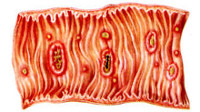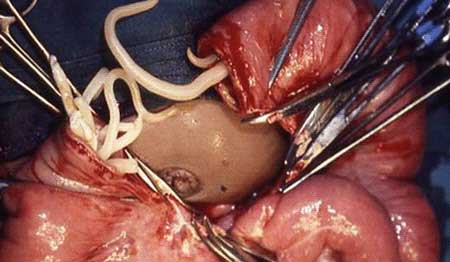Viral enteritis is an acute infectious disease caused enterotropic viruses, which can occur as an isolated lesion of the small intestine, or involvement of other organs and systems. Most often the causative agents of viral enteritis are rotaviruses, enteroviruses, Coxsackie virus and echo.
The source of infection – a sick person or a carrier. The typical symptoms of intoxication, diarrheal syndrome, vomiting. The diagnosis is confirmed by detecting the genetic material of a microorganism and a fourfold rising titer of specific antibodies.
Treatment of viral enteritis is based on detoxification and symptomatic events. Specific antiviral therapy is available.
Viral enteritis
Viral enteritis is an acute viral infection of the small intestine characterized by symptoms of intoxication and digestive disorders. Can occur in the form of enteritis, gastroenteritis, gastroenterocolitis. In recent years there has been a trend towards increased viral intestinal infections in the world. In developed countries, is continuously recorded increase in morbidity, mainly among children and adolescents.
Feature of pathology is a long-term healthy virus, in which a person has no symptoms, but is a source of infection. Pathogens may reside in the gut for several months, and also have a high resistance in the external environment. They are capable of long remain in the water, what caused the massive outbreak of viral enteritis. All of these factors combined with the variety enterotropic a virus contribute to high prevalence of pathology.

Causes viral enteritis
Agents of the disease are viruses that possess a tropism for epithelial and lymphoid tissue of the small intestine. The most important in the morbidity structure of rotaviruses and members of the genus Enterovirus (Coxsackie virus, echo, polioviruses, enteroviruses 69, 71, 73, 77, 78). Viral enteritis may cause more than one hundred unclassified microorganisms, what is the complexity of diagnosis and the lack of specific treatment. All pathogens are resistant to physico-chemical factors, including to many disinfectants.
The source of infection viral enteritis – persons with clinical signs or virus. Of particular risk are patients with asymptomatic form. Spread of infection occurs contact-household (in the lack of personal hygiene, poor hand washing after visiting the toilets), water (by drinking contaminated water, especially from public sources) and alimentary infections (when used in a contaminated food). Possible vertical transmission enterotropic virus (from mother to fetus), this is an important role for latent viral enteritis in a pregnant woman.
For outbreaks of viral enteritis typical summer-autumn seasonality. After recovery remains long-lasting immunity, however, the diversity of pathogens leads to the possibility of repeated re-infection.
Penetrating the gastrointestinal tract, microorganisms are embedded in the mucous membrane of the small intestines, where rapidly proliferate and accumulate. The viability of the virus leads to the death of epithelial cells, the rejection of the villi. In the process of recovery of dead fibers in viral enteritis of the mucous membrane cells of the digestive tract cannot function normally, therefore simple carbohydrates are not absorbed. The accumulation of these components in the intestinal lumen increases the osmotic pressure and leads to malabsorption of electrolytes, water and the development of diarrheal syndrome.
The symptoms of viral enteritis
Symptoms of intestinal infections vary depending on the causative agent, but there are common signs. Usually viral enteritis begins with increase in body temperature to subfebrile (37-38° C). Patient concerned weakness, loss of appetite and headache. Repeated vomiting (up to ten or more times a day) is usually preceded by diarrhea. Stool thin, watery, frothy, without impurities mucus and blood. In severe viral enteritis stool frequency can reach twenty times a day. Decreases the volume of urine.

Possible moderate continuous abdominal pain. These symptoms in most cases are accompanied by catarrhal symptoms: runny nose, nasal congestion, sore throat and redness of the throat. Often from the first day on the body rash appears, which then disappears. When abortive form of viral enteritis the symptoms are less pronounced and quite rapidly. The virus has no clinical signs and can only be detected by the laboratory.
Intestinal viruses have an affinity for many tissues of the human body, so most manifestations of the disease are not limited to enteritis. The process can involve the Central nervous system, the mucous membrane of the respiratory tract, conjunctiva of the eyes, liver, heart and muscles.
In the case of lesions of the oropharyngeal disease is accompanied by hyperemia of its mucous membrane, bubble rash on the arches of the tonsils. Viral conjunctivitis is characterized by eye redness, photophobia, tearing and small bleeding. The defeat of the muscular system proceeds as polymyositis with soreness in different muscle groups. From the cardiovascular system in viral enteritis possible signs of myocarditis, and endocarditis (fatigue, palpitations, arrhythmias and lowering blood pressure). Lymphotropic viruses (e.g., adenovirus) lead to swollen lymph nodes. Enterovirus meningitis, encephalitis accompanied by headache, nausea, vomiting, convulsions, loss of consciousness.
Diagnosis of viral enteritis
A presumptive diagnosis of viral enteritis gastroenterologist and infectious disease exhibit, given the peculiarities of the clinical course of the disease and epidemiological situation in the region. On examination of the patient is pale skin, reduced skin turgor, dryness of tongue. Enteritis caused by adenovirus, is characterized by an increase of different groups of lymph nodes. In the clinical analysis of blood in viral enteritis increased white blood cell count and erythrocyte sedimentation rate. Is defined in the coprogram undigested fiber, starch grains and neutral fats; the study on a dysbacteriosis reveals the low content of bifidobacteria, lactobacilli.
For the detection of specific immunoglobulins and the causative agent of viral enteritis conducted serological and virological tests, but they take a few days, do not allow to distinguish between virus from acute symptomatic forms. More important diagnostic criterion for acute phase viral enteritis – a fourfold increase in antibody titer in paired sera and detection of RNA or DNA virus by polymerase chain reaction (PCR). Differential diagnosis of viral enteritis is intestinal diseases, influenza, acute respiratory infections of enterovirus etiology is not, meningococcal and tuberculous meningitis, rubella, measles, and other diseases depending on the prevailing syndrome.
Treatment of viral enteritis
Specific etiotropic therapy of viral enteritis have not been developed. The main directions in the treatment of enteritis clinical gastroenterology believes detoxification and symptomatic events. In milder forms the treatment in the outpatient, in severe cases with marked dehydration in conditions of infectious hospital. Dietary therapy for viral enteritis involves the exclusion of dairy products, carbohydrates (fruits and vegetables); recommended liquid food rich in protein, vitamins and minerals. Shown plentiful drink (regidron), with severe fluid loss due to diarrhoea and repeated vomiting is infusion rehydration (intravenous solutions are introduced, compensating the loss of water and electrolytes).
Appointed immunomodulatory drugs, interferon, chelators. In the case of hyperthermia, severe muscle and head pain with viral enteritis are applied analgesics and antipyretic drugs. To normalize the microflora of the used probiotics (products containing beneficial gut bacteria) and prebiotics (substances that create favorable conditions for the settlement of the flora).
Prognosis and prevention of viral enteritis
With timely treatment prognosis is favorable. In case of dehydration may develop complications, such as renal and cardiovascular failure. In the case of severely impaired immunity, presence of concomitant pathology of viral enteritis becomes severe, particularly if the pathogen has a tropism for the Central nervous system.
Prevention of viral enteritis is in compliance with the measures of personal hygiene, thorough washing of fruits and vegetables consumed in their raw form, drink only purified water, limit visits to crowded places during epidemics, and the regular conduct of restorative procedures. Cases of viral enteritis, the family member should be isolated in a separate room and use individual utensils and towels. Specific prevention of viral intestinal infections (vaccination) has not been developed.




I actually wanted to write a message in order to thank you for some of the great ideas you are showing on this website. My extended internet look up has finally been compensated with beneficial knowledge to go over with my partners. I ‘d repeat that we readers are undeniably fortunate to be in a great network with very many brilliant individuals with great basics. I feel rather blessed to have discovered the website and look forward to tons of more cool moments reading here. Thank you once more for everything.
Hello there! This blog post could not be written any better! Reading through this article reminds me of my previous roommate! He always kept preaching about this. I most certainly will send this post to him. Pretty sure he’s going to have a great read. Many thanks for sharing!